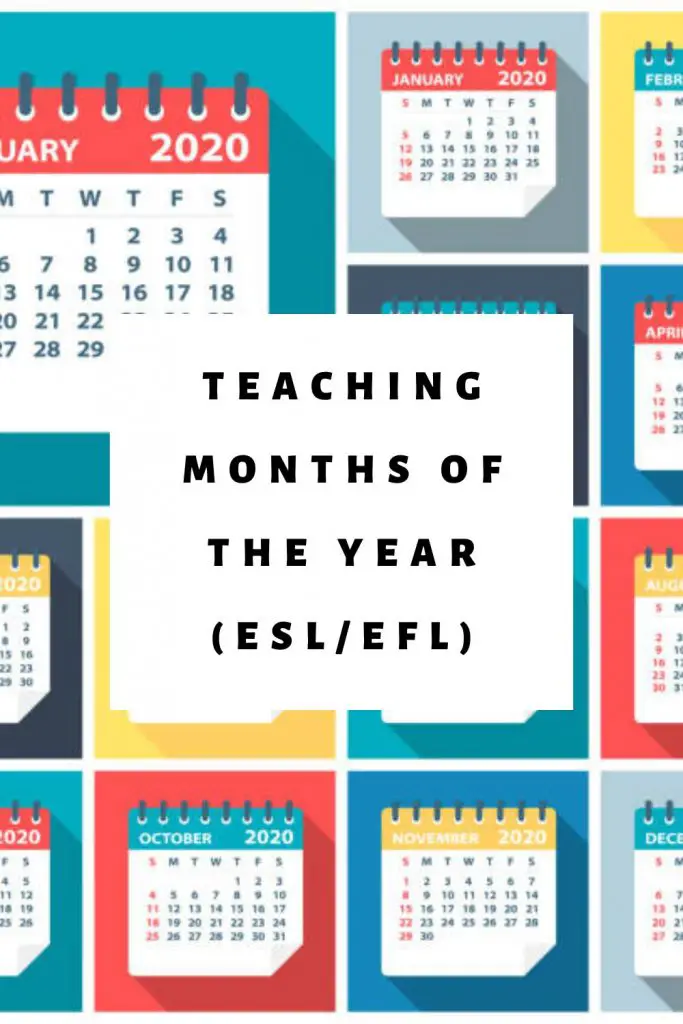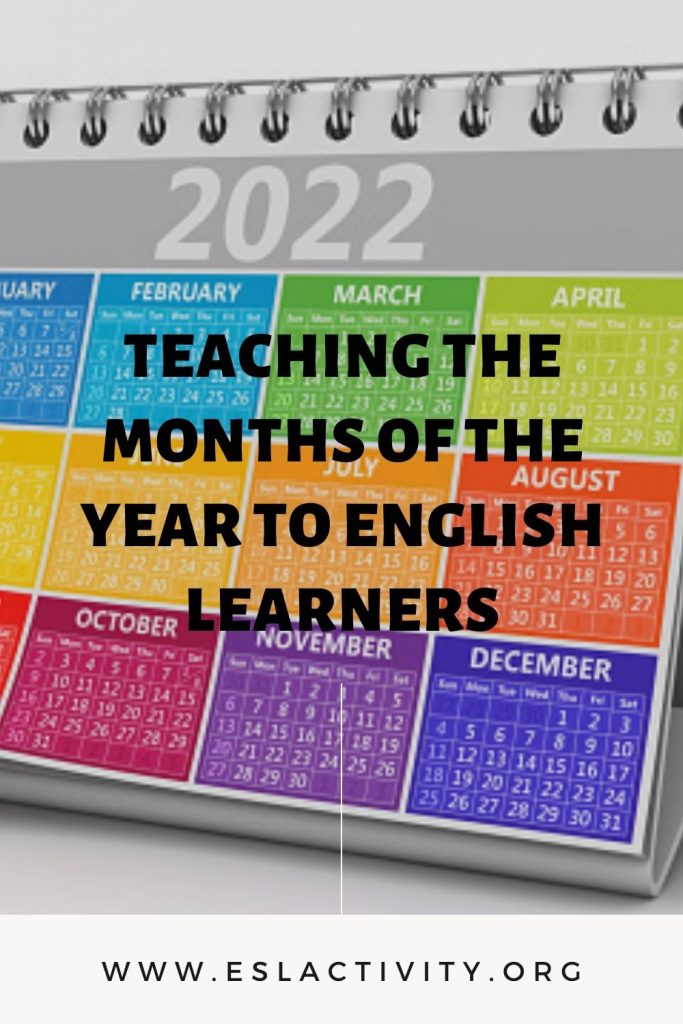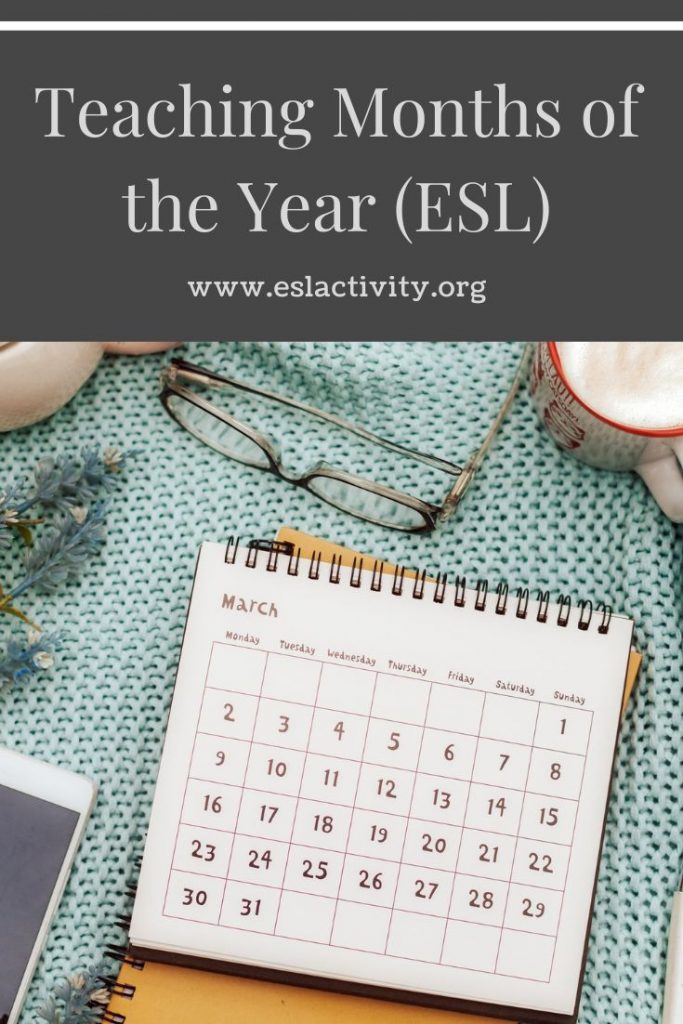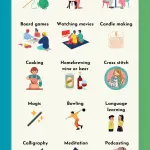Teaching the months of the year doesn’t have to be boring! There are lots of fun ESL games and activities for teaching the months, in English. Keep on reading for lots of ideas, along with months of the year lesson plans, worksheets, and online practice suggestions.

How to teach the months of the year
Teaching Months of the Year Activities
If you’re looking for some of the best ideas to teach months of the year in English, then you’re in the right place. Check out this list for everything you need to do it in style!
#1: English Idioms for Months
There are a lot of English idioms that use a month in them. Here are some quick examples:
- April showers bring May flowers.
- It’ll be a long day in January.
- A cold day in July.
- May-December romance.
- March comes in like a lion and goes out like a lamb.
- Slower than molasses in January.
- The flavour of the month.
- Mad as a March hare
Check out this fun activity you can do:
#2: Months of the Year Survey
Just ask my students and they’ll tell you that I love to use surveys in my classes. They’re fun, engaging, cover a range of skills and can work with just about any topic. For months, you can include some questions on the survey like the following. Do you…
- …think January is the worst month?
- ….think August is the best month?
- ….go to the beach in the summer?
- ….think that July is too hot?
- ….visit family in December?
- Etc.
Find out more about them here: ESL Surveys and Questionairres.
#3: Man/Woman on the Street Interview Activity
Try out this fun ESL interview activity that turns the usual (finding out an opinion about something) into something more interesting! Get a microphone and your students can get to work, finding out what people’s favourite months are.
#4: Just a Minute
If you’re talking about the months or seasons with higher-level students, then consider using Just a Minute. Get students to talk about their favourite month of the year. The challenge is that they have to talk for an entire minute without stopping.
#5: Word Association
It’s likely that students already know a good deal of information about the months, seasons, and holidays so this activity is a nice one to do at the start of the lesson. It can help students activate their prior knowledge about the topic before adding new information.
It’s basically a mind map. Students can shout out months, seasons, activities, holidays, etc. Group them into categories in a kind of mind map. Learn more about it:
ESL Word Association Activity.
#6: Videos for Teaching the Months
If you take a look on YouTube, there are so many ESL videos designed to teach the months to English learners. There are so many fun songs and chants for all ages. If you’re not musical, not to worry!
#7: Order the Months
This is a nice activity for people who are just getting started with the months in English. Print out the names of the months and then laminate them. Students have to work together in groups to put them into the correct order. You can also add an element of friendly competition to it.
#8: Months Reading Lesson
It’s easy to plan a reading lesson about almost any topic, including this one. Have a look right here at the simple steps you can follow:
#9: Dictogloss
Try out this challenging listening activity with your higher-level students. Find, or write a passage with a lot of the target vocabulary in it. Put students into pairs with a pencil and paper. Read out the passage quite quickly and students have to take notes. The goal is to recreate what they just heard. Read it out again and then students can compare what they have with the original. Check it out:
#10: Touch the Month
I like to print out and laminate large-print versions of the months. Then, I put them at various points around the classroom on the walls.
Students have to stand up and I give hints about the words. For absolute beginners, I just say the word (June) and students have to touch or stand in front of it.
You can do other things too:
- Touch your favourite month.
- Touch your least favourite month.
- It’s the month after November.
- It’s the month before February.
#11: Have a Debate
A fun way to get students talking about the months of the year is to have a debate. Make a statement such as, “August is the best month of the year.” There will be people who agree, as well as disagree. Set up some debates amongst those people and have some fun chatting about it! More ideas here:
#12: Dictation Practice
I know that dictation is a little bit old school but it does have some value, particularly when teaching the months in English. The spelling can be a little bit tricky and of course, they also require a capital letter. Check it out here:
#13: Me Too!
This is a very simple reading activity for beginners. Students have to make true statements using a month. For example:
- My birthday is in May.
- I go skating in February.
- I stay inside during January.
- I think July is too hot.
If someone agrees, they have to raise their hand and say, “Me too!” Find out more:
#14: Error Correction Relay Race for Months of the Year
This is a nice activity for focus on the spelling of the months in English. Make up a worksheet with some errors. They could be things like spelling, punctuation or even dealing with meaning. Then, students have to race to make all of the corrections. Check it out:
Error Correction Relay Race ESL.
#15: Get a Calender Out!
Students probably already know the months in their own language. Get an English calendar and bridge the gap. Say the names of the months and have students repeat after you. Point out key holidays as well.
#16: Listening Lesson Plan with Months of the Year
It’s easy to plan an ESL/EFL listening lesson about almost any topic, including this one. Check out these simple steps to follow:
#17: Find Someone Who Bingo Game
This activity is ideal for a “get-to-know-you” activity but it also works well for anything fact or opinion related. Fill up the board with things like:
- Has a birthday in November.
- Thinks July and August are the best months.
- Has a birthday in April.
- Goes on vacation in December.
- Etc.
Then, students have to find classmates who answer yes to these questions in order to get a bingo. Find out more:
Find Someone Who Bingo ESL Game.
#18: Holiday Lessons
When talking about the months of the year, holidays inevitably come up too. It’s fun to incorporate some activities or games related to these holidays throughout the year. Here are some of my top ideas:
#19: The Word Challenge Whiteboard Race
Try out this fun whiteboard activity for students who are just learning how to spell the months. For absolute beginners, you could simply say the month (September) and they have to race to spell it. For slightly higher-level students you can give a hint (it’s the month after March) and they have to write the answer (April).
#20: Opinion Games and Activities
Everyone has an opinion about what the best and worst months of the year are. So why not get students to share their opinions with others? Check out some of my favourite activities and games to help them do that:
#21: Days of the Week
Months and days are a natural fit! When doing a lesson on the months, I like to throw in some review about the days of the week, along with the seasons. Have a look here:
Days of the Week ESL Activities.
#22: Plan an ESL Speaking Lesson for the Months
It’s easy to plan an ESL lesson for any topic, including this one by following these simple steps:
#23: Calendar Races
Divide the class into teams and give each team a large calendar with the months jumbled up. Call out a month, and teams race to find and place the correct month on their calendar. The first team to complete the calendar correctly wins.
#24: Memory Game
Create a set of month cards with the name of the month written on one card and a corresponding picture or symbol representing that month on another card. Shuffle the cards and place them face down. Students take turns flipping two cards to find a matching pair of month and picture cards. The student with the most pairs at the end of the game wins.
#25: Month Charades
Write the names of different months on separate slips of paper and place them in a hat or container. Students take turns picking a slip and acting out activities or events associated with that month without speaking. The rest of the class tries to guess the month being acted out.
#26: Timeline Game
Create a large timeline on the board or a poster paper with the months of the year in random order. Students work together to rearrange the months and place them in the correct chronological order. This activity helps reinforce the sequence of the months.
#27: Month Puzzles
Create puzzles with the names of the months split into two or three pieces. Distribute the pieces among the students and have them find their puzzle partners to complete the months. This activity promotes collaboration, critical thinking, and month recognition.
#28: Month Word Search
Provide students with word search puzzles where the names of the months are hidden among other letters. Students need to find and circle the words as quickly as possible. You can find ready-made word search puzzles online or create your own.
#29: New Year’s Eve Sayings
Have some fun with the new year and a fresh start. Have a look at these popular expressions:
#30: Seasons and Months Matching
Create cards or flashcards with pictures representing each season (e.g., snowflakes for winter, flowers for spring) and cards with the names of the months. Students match the correct month card to the corresponding season card, discussing the characteristics of each season along the way.
#31: Guess the Month
Describe an event or activity associated with a specific month without revealing the name of the month. Students take turns guessing which month is being described based on the clues given. For example, “This month has a holiday where people dress up in costumes and go trick-or-treating.”
#32: Month Collage
Assign each student or pair of students a month of the year. They create a collage or poster representing that month, including pictures, symbols, or words associated with events or characteristics of that month. Students present their collages to the class, describing the elements they included.
Teaching Months of the Year Lesson Plans

Teaching months of the year in English
Months of the Year English Worksheets
Online Practice for the Months in English
Need More Ideas for Teaching English Vocabulary?
- Amazon Kindle Edition
- Bolen, Jackie (Author)
- English (Publication Language)
- 70 Pages - 11/28/2015 (Publication Date)
The key to great English classes is a wide variety of games and activities. This book will help you do that! You can easily find 39 ESL Vocabulary Activities for Kids on Amazon.
Check it out today and get ready for better English classes with children tomorrow:
FAQs
Here are the answers to some of the most common questions that people have about this topic.
Why is it important to learn the months of the year?
It’s important to learn the months of the year because they offer a framework for lots of other stuff, including holidays, birthdays, days of the week, seasons and more.
How do you teach months of the year ESL?
To teach months of the year ESL, first introduce the names, pronunciation and spelling for the months. A nice way to do this is with a calendar. Then, do some practice exercises and games.
How do you remember the months?
A nice way to remember the months is to learn a song or chant. Have a look on YouTube for lots of options.
How can I reinforce the learning of the months of the year?
You can reinforce the learning of the months by incorporating activities such as calendar-based exercises, interactive games, worksheets, or asking students to share personal experiences or events related to each month.
Are there any cultural considerations when teaching the months of the year?
Yes, it’s important to consider cultural differences and variations in holidays and seasons when teaching the months of the year. Discussing and comparing cultural celebrations and traditions associated with different months can enrich the learning experience.
How can I practice using the months in context?
You can practice using the months in context by engaging in activities such as role-playing conversations about scheduling appointments, discussing favorite months or seasons, or describing events that happen in specific months.
How can I address difficulties students might have in remembering the months?
If students have difficulty remembering the months, provide additional practice opportunities, use visual aids or mnemonic techniques, encourage regular review, and create a supportive and engaging learning environment.
Can learning the months of the year be integrated with other language skills?
Yes, learning the months of the year can be integrated with other language skills. For instance, you can incorporate reading by discussing events or holidays associated with different months, writing by creating monthly journals or calendars, and listening by listening to songs or dialogues that mention specific months.

ESL months of the year
Teach Months of the Year: Join the Conversation
Do you have any games or activities that you like to use when teaching the months in English? Leave a comment below and let us know. We’d love to hear from you.
Last update on 2022-07-17 / Affiliate links / Images from Amazon Product Advertising API






